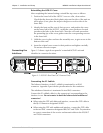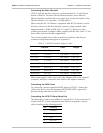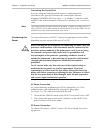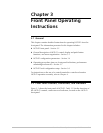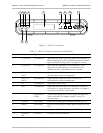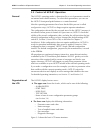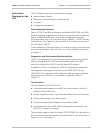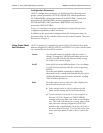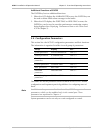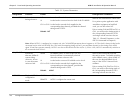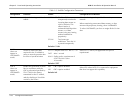
HCD-E1 Installation & Operation Manual Chapter 3 - Front Panel Operating Instructions
11/01/00 19:52 Control of HCD-E1 Operation 3-3
3.3 Control of HCD-E1 Operation
General
The HCD-E1 operating mode is determined by a set of parameters stored in
an internal non-volatile memory. To select these parameters, you can use
the HCD-E1 front panel push buttons or a control terminal.
After the operating parameters have been loaded (this process is called
configuration setup), HCD-E1 no longer requires operator attendance.
The configuration selected by the user and stored in the HCD-E1 memory is
not affected when power is turned off. Upon turn-on, HCD-E1 checks the
validity of the stored configuration data, and after the self-test takes the last
selected configuration (unless you have changed the default setting of DIP
switch S1, Section 2, from OFF to ON, as described in Chapter 2,
Installation). If the configuration does not require modification, HCD-E1 is
ready for operation immediately after power is applied. However, if the
configuration data is corrupted, HCD-E1 loads a default configuration
instead. The default configuration, prepared by the manufacturer, is stored
in the EPROM.
All operations are performed using an interactive, menu-driven interface,
controlled by the LCD and three push buttons. HCD-E1 guides you in the
execution of the required task by means of messages and checks your
inputs. Moreover, HCD-E1 will suggest you only those parameter values
which are available on your HCD-E1 model in the selected operating mode.
If you make a configuration error (for example, you select a parameter value
that conflicts with the current operating mode), HCD-E1 rejects the
erroneous selection and displays an error message that identifies the error.
For detailed operating instructions, see Section 3.5 and Section 3.6.
Organization of
the LCD
The HCD-E1 display has two rows:
•
The upper row shows the header, which can be one of the following:
- ALARM BUFFER
- PORT DIAG
- HDSL DIAG
- TEST OPTION
- Name of one of seven configuration parameter groups
(see Section 3.4)
•
The lower row displays the following information:
− Parameter name and value
− Status messages
− Test or loopback name and status
− Error messages
− Diagnostics messages
Figure 3-2 shows the basic LCD menu structure.






